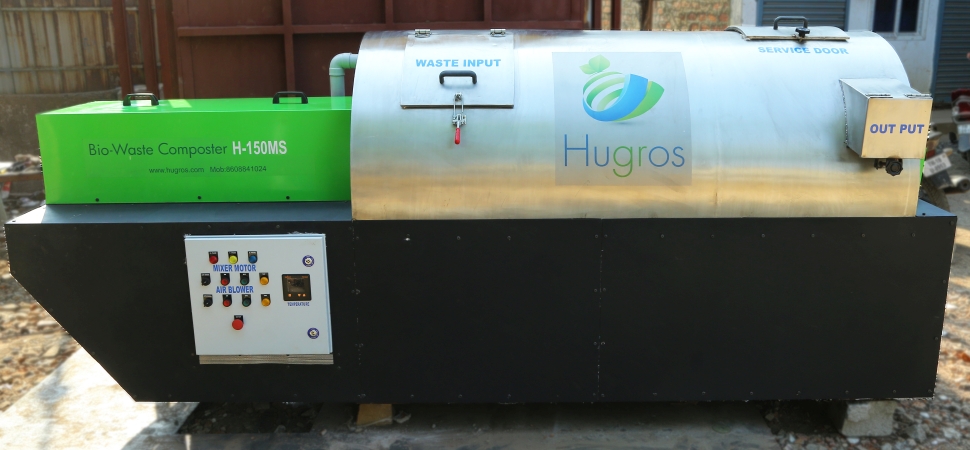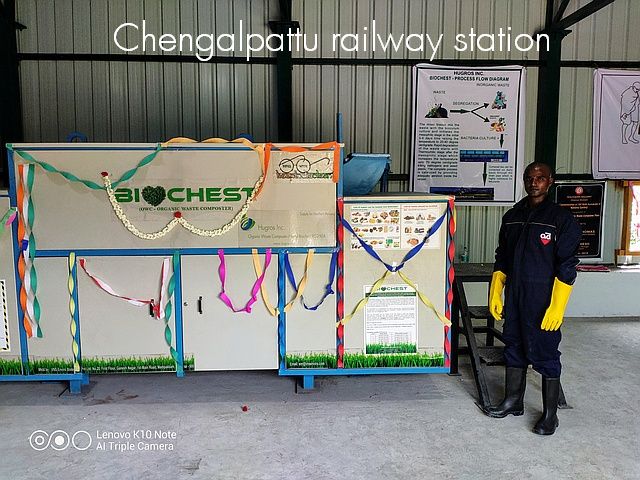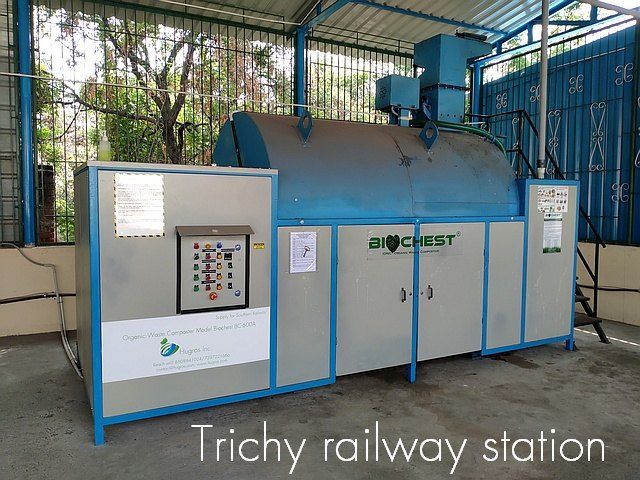
NON HEATING TYPE IN VESSEL DRUM TYPE ORGANIC WASTE COMPOSTER
Our organic waste composter converts the biodegradable
waste or food waste into compost (fertilizer) naturally with
the help of mesophilic and thermophilic bacterias. We do not
use any external heating or other systems to create charcoal
like compost as claimed by the 24 hrs composting machines
widely spread in the market. Our food waste composter was developed after extensive research and development
carried out in the past years evolving to a better design
for a composter to ensure a natural composting process.
• “A process
in which compostable material is enclosed in a drum, silo,
bin, tunnel, reactor, or other container for the purpose of
producing compost, maintained under uniform conditions of
temperature and moisture where air-borne emissions are
controlled”
• Uses
forced aeration and/or mechanical agitation to control
conditions and promote rapid
composting
• Each
system design is different, but there are some common
elements.
Advantages
of In-Vessel Composting
• Composting
can be more closely controlled, leading to faster
decomposition and more Consistent product quality.
• Effects of
weather are diminished
• Less
manpower is required to operate the system and staff is less
exposed to composting material
• Can often
be done onsite, saving collection costs
• Less land
area is required
• Process
air and leachate can be more easily collected and treated
• Public
acceptance of facility may be better
• Can
accommodate various types and amounts of organic waste
(e.g., odorous bio solids & food)
Factors
responsible for composting
CARBON:
NITROGEN RATIO
Raw
materials blended to provide a C:N ratio of 25:1 to 30:1 are
ideal for active composting, although initial ratios of 20:1
up to 40:1 consistently give good results.
OXYGEN
Oxygen is
very important in composting because it enhances the growth
of aerobic bacteria. Aerobic bacteria are bacteria that grow
and live in the presence of oxygen and are very efficient in
breaking down waste.
TEMPERATURE
Microbial
decomposition during composting releases large amounts of
energy as heat, which raises the temperature. Composting is
most efficient when the temperature of the composting
material is between 55-60 degree Centigrade . Composting
stops if the compost becomes too cold or too hot. Hence the
temperature to be monitored.
MOISTURE
Moisture is
the lifeblood of the metabolic processes of the microbes.
Water provides the medium for chemical reactions, transport
nutrients and allows the microorganisms to move from place
to place. Efficient activity is achieved when the moisture
is maintained between 40% and 60%. More the surface area,
the faster the decomposition and the more usable compost
BIOWASTE COMPOSTER
Our organic waste or food waste composting machines uses specially designed
two way aeration system and mechanical agitation to control conditions
and promote rapid composting. Our natural organic waste
composting machine is a
combination of a device and process, targeting the quickest
transformation of biological; waste into consistent -
quality compost at the lowest possible cost and management
effort.
Salient features of
our biowaste composter compared to other systems
Disadvantages in other Machines
Advantages in
Hugros Biowaste composter
No time, microbes and
oxygen (air) provided in this system - So it is
not a composting system
We are adding microbes, providing aeration
through blowers and providing enough time for
the microbes to do their work. In our reactor we
are providing all the required biotic and
abiotic factors required for the microbes to
work.
Depends on the heating element
No heating element, The Microbes present,
themselves will produce the heat required
naturally
Just charring the waste into black
colored char by heating
Waste are not charred artificially, they are
composted
by the microbes naturally by the process of
aerobic
composting
No nutrient value in the
charred material
Very high nutrient value, with more amount of
readily
available nitrogen for plants
Power intensive, has it needs enormous
heating load
Less power intensive, as there is no heating
element
Cannot be used as a fertilizer
Can be used as High quality organic fertilizer
It’s is not a composting reactor, just
a mixer. As per the international composting
councils the temperature should be maintained
50-60 degree centigrade by removing excess heat
by circulating the air inside instead it is
fried at more than 100 degree centigrade.
We are adding microbes, providing aeration
through blowers and providing enough time for
the microbes to do their work. In our reactor we
are providing all the required biotic and
abiotic factors required for the microbes to
work (Composting).
Needs larger area for curing
No large area needed, only limited space needed
for storage bins
No provision provided to control odour
and obnoxious gases produced during composting
or mixing process
Our reactor has an inbuilt Biofilter, which
removes all
the odour and scrubs the obnoxious gases
produced
during composting or mixing process. Our
system is Odour free
Dangerous gases like SO2 are not
scrubbed, will lead to health issue
The biofilter will scrub all the obnoxious gases
like
SO2 produced during the composting process. And
releases only the odour free gases out
SPECIFICATIONS
MODEL
CAPACITY
(KG/DAY)
SPACE REQUIRED (MM)
DIMENSIONS (MM)
WEIGHT
(KG)
POWER CONSUMPTION/DAY
(Rs.)
BACTERIA CULTURE
COST/DAY (Rs.)
L
W
H
A
B
C
BC - 25A
25
2600
1800
2200
1600
800
1200
550
105
2.5
BC - 50A
50
2800
2000
2300
1800
1000
1300
650
105
5
BC – 100A
100
3250
2200
2500
2250
1200
1500
800
126
10
BC – 250A
250
4000
2500
2500
3000
1470
1750
1250
168
25
BC – 500A
500
4600
2800
3100
3600
1800
2100
1950
231
50
BC – 750A
750
5000
2900
3500
3600
2200
2600
1950
231
75
BC – 1000A
1000
5500
3000
3500
4500
2300
2600
2700
336
100
BC – 1500A
1500
5500
3000
3500
4750
2700
2600
2800
336
150
Electricity charge considered @ Rs.7/ Unit
Note:
we
suggest organic shredder to be used with machines of
100kg/day capacity or more for better composting.
Organic waste composting plant video
Organic waste composting machine installations at Indian railway

